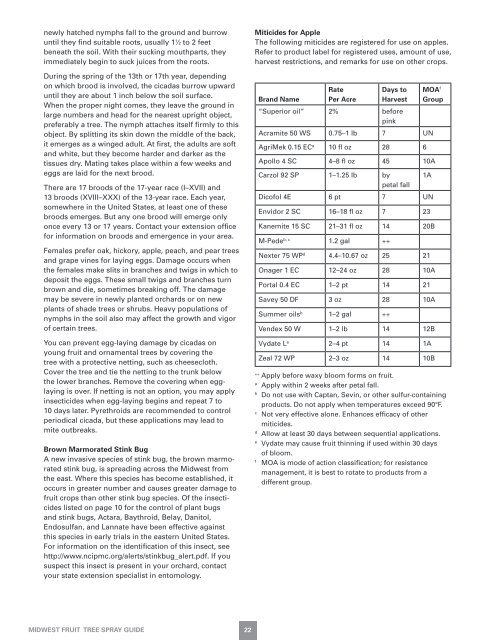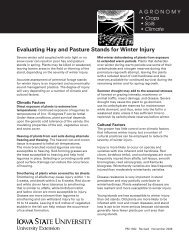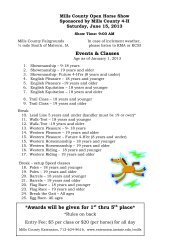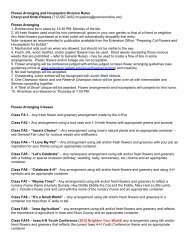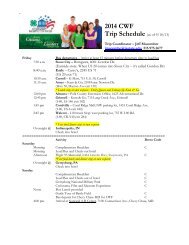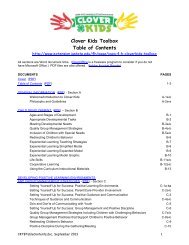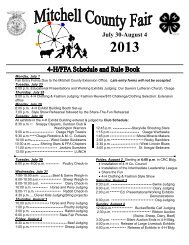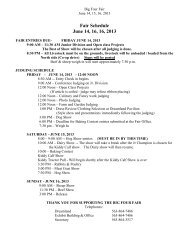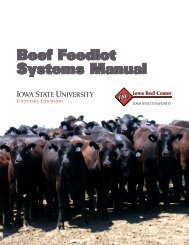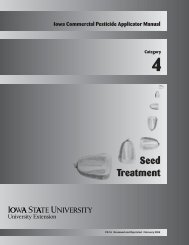Midwest Tree Fruit Spray Guide - Iowa State University Extension ...
Midwest Tree Fruit Spray Guide - Iowa State University Extension ...
Midwest Tree Fruit Spray Guide - Iowa State University Extension ...
Create successful ePaper yourself
Turn your PDF publications into a flip-book with our unique Google optimized e-Paper software.
newly hatched nymphs fall to the ground and burrow<br />
until they find suitable roots, usually 1 1 ⁄2 to 2 feet<br />
beneath the soil. With their sucking mouthparts, they<br />
immediately begin to suck juices from the roots.<br />
During the spring of the 13th or 17th year, depending<br />
on which brood is involved, the cicadas burrow upward<br />
until they are about 1 inch below the soil surface.<br />
When the proper night comes, they leave the ground in<br />
large numbers and head for the nearest upright object,<br />
preferably a tree. The nymph attaches itself firmly to this<br />
object. By splitting its skin down the middle of the back,<br />
it emerges as a winged adult. At first, the adults are soft<br />
and white, but they become harder and darker as the<br />
tissues dry. Mating takes place within a few weeks and<br />
eggs are laid for the next brood.<br />
There are 17 broods of the 17-year race (I–XVII) and<br />
13 broods (XVIII–XXX) of the 13-year race. Each year,<br />
somewhere in the United <strong>State</strong>s, at least one of these<br />
broods emerges. But any one brood will emerge only<br />
once every 13 or 17 years. Contact your extension office<br />
for information on broods and emergence in your area.<br />
Females prefer oak, hickory, apple, peach, and pear trees<br />
and grape vines for laying eggs. Damage occurs when<br />
the females make slits in branches and twigs in which to<br />
deposit the eggs. These small twigs and branches turn<br />
brown and die, sometimes breaking off. The damage<br />
may be severe in newly planted orchards or on new<br />
plants of shade trees or shrubs. Heavy populations of<br />
nymphs in the soil also may affect the growth and vigor<br />
of certain trees.<br />
You can prevent egg-laying damage by cicadas on<br />
young fruit and ornamental trees by covering the<br />
tree with a protective netting, such as cheesecloth.<br />
Cover the tree and tie the netting to the trunk below<br />
the lower branches. Remove the covering when egglaying<br />
is over. If netting is not an option, you may apply<br />
insecticides when egg-laying begins and repeat 7 to<br />
10 days later. Pyrethroids are recommended to control<br />
periodical cicada, but these applications may lead to<br />
mite outbreaks.<br />
Brown Marmorated Stink Bug<br />
A new invasive species of stink bug, the brown marmorated<br />
stink bug, is spreading across the <strong>Midwest</strong> from<br />
the east. Where this species has become established, it<br />
occurs in greater number and causes greater damage to<br />
fruit crops than other stink bug species. Of the insecticides<br />
listed on page 10 for the control of plant bugs<br />
and stink bugs, Actara, Baythroid, Belay, Danitol,<br />
Endosulfan, and Lannate have been effective against<br />
this species in early trials in the eastern United <strong>State</strong>s.<br />
For information on the identification of this insect, see<br />
http://www.ncipmc.org/alerts/stinkbug_alert.pdf. If you<br />
suspect this insect is present in your orchard, contact<br />
your state extension specialist in entomology.<br />
MIDWEST FRUIT TREE SPRAY GUIDE<br />
22<br />
Miticides for Apple<br />
The following miticides are registered for use on apples.<br />
Refer to product label for registered uses, amount of use,<br />
harvest restrictions, and remarks for use on other crops.<br />
Brand Name<br />
Rate<br />
Per Acre<br />
Days to<br />
Harvest<br />
MOA f<br />
Group<br />
“Superior oil” 2% before<br />
pink<br />
Acramite 50 WS 0.75–1 lb 7 UN<br />
AgriMek 0.15 EC a 10 fl oz 28 6<br />
Apollo 4 SC 4–8 fl oz 45 10A<br />
Carzol 92 SP 1–1.25 lb by<br />
petal fall<br />
1A<br />
Dicofol 4E 6 pt 7 UN<br />
Envidor 2 SC 16–18 fl oz 7 23<br />
Kanemite 15 SC 21–31 fl oz 14 20B<br />
M-Pede b, c 1.2 gal ++<br />
Nexter 75 WP d 4.4–10.67 oz 25 21<br />
Onager 1 EC 12–24 oz 28 10A<br />
Portal 0.4 EC 1–2 pt 14 21<br />
Savey 50 DF 3 oz 28 10A<br />
Summer oils b 1–2 gal ++<br />
Vendex 50 W 1–2 lb 14 12B<br />
Vydate L e 2–4 pt 14 1A<br />
Zeal 72 WP 2–3 oz 14 10B<br />
++ Apply before waxy bloom forms on fruit.<br />
a Apply within 2 weeks after petal fall.<br />
b Do not use with Captan, Sevin, or other sulfur-containing<br />
products. Do not apply when temperatures exceed 90°F.<br />
c Not very effective alone. Enhances efficacy of other<br />
miticides.<br />
d Allow at least 30 days between sequential applications.<br />
e Vydate may cause fruit thinning if used within 30 days<br />
of bloom.<br />
f MOA is mode of action classification; for resistance<br />
management, it is best to rotate to products from a<br />
different group.


